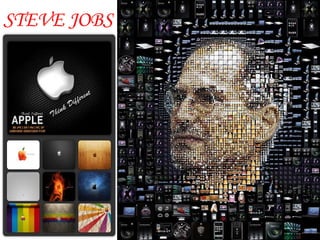Steve Jobs
- 1. STEVE JOBS
- 2. Steven Paul Jobs Born in 1955 in Green Bay, Wisconsin Adopted by Paul and Clara Jobs to live in Santa Clara, California Graduated high school in Cupertino, California
- 3. Education Jobs went to Reed College in Portland Oregon He studied Poetry, Literature, and Physics After one semester, Jobs dropped out of school, but still attended some classes.
- 4. Steves Jobs met Steve Wozniak shortly after they both left school while working for Hewlett-Packard ※ Woz§ was an incredibly talented engineer, especially in electronic gadgets While developing a ※blue box§ device, Jobs convinced Woz to sell it to Berkeley students.
- 5. The Beginnings of Apple After spending time in India in 1974, Jobs returned to America He visited with Woz the homebrew computer club, but was not content with just the creation of electronics.
- 6. Jobs convinced Woz to help him create a personal computer, the Apple I Jobs, with marketing help from a friend, had the vision of creating a computer company that would make and sell pc*s. After showing the Apple I to in town computer stores, Jobs was able to sell 25. After selling his Volkswagen mini-bus, and asking Woz to sell his scientific calculator, they two raised enough money to create Apple Computers.
- 7. Apple Jobs and Woz sold the Apple I in 1976 for $666, making over $776,000 from sales In 1977, they two released the Apple II, a single board computer with onboard ROM and a color video interface.
- 8. Positive Growth From 1977 to 1983, Apple continued to grow exponentially. In 1981, IBM finally entered the personal computer market, and in just two years began to outsell Apple. After the failure of the Apple III and Lisa, Jobs needed a new computer that could compete with the IBM PC.
- 9. The Macintosh In 1984, Apple released the Macintosh, the first personal computer with a graphical user interface(GUI). It had 128KB of memory, and was expandable. Along with the mouse, the Macintosh was the most revolutionary computer made up to that point.
- 10. Microsoft and John Sculley In 1985, Bill Gates convinced Jobs to license the graphical user interface in the Macintosh to create Windows, which could run on IBM PC*s. As sales of the Macintosh took off, CEO John Sculley thought that Jobs was hurting Apple*s success, and gradually forced Jobs to leave.
- 11. Jobs project in the late 1980*s to mid 90*s was NextStep. A new computer company based on an object oriented software platform, NeXT failed first as a hardware company, then as a software company. Apple similarly did very poorly in the early and mid 90*s, brought on by poor leadership and stagnating computer design.
- 12. The Second Coming of Jobs In 1996, Apple bought NeXT, and with it came Steve Jobs. In 2000, Jobs became the full CEO of Apple, after the success of the iMac, the first computer mainly marketed for its looks.
- 13. Return to Profitability and Innovation Jobs continues to innovate the computer industry, spearheading projects like the iPod, iTunes and its Music Store, and high end computer. Under Jobs* watch, Apple has entered a new phase of growth and profitability, fueled by his imagination and quest for perfection.
- 14. Apple*s market value was $222.1 billion, higher than Microsoft*s $219.2 billion.? As per May 26 th , 2010. As Microsoft is only Operating System (OS) software. Where as Apple prepares its own hardware and software too. Apple is now the most valuable technology firm in the world. ?














